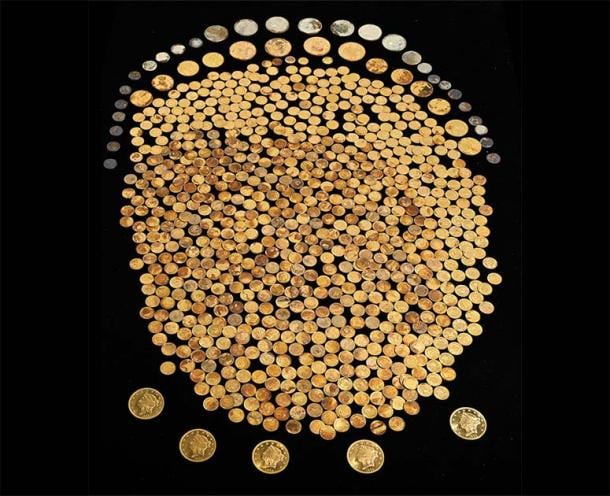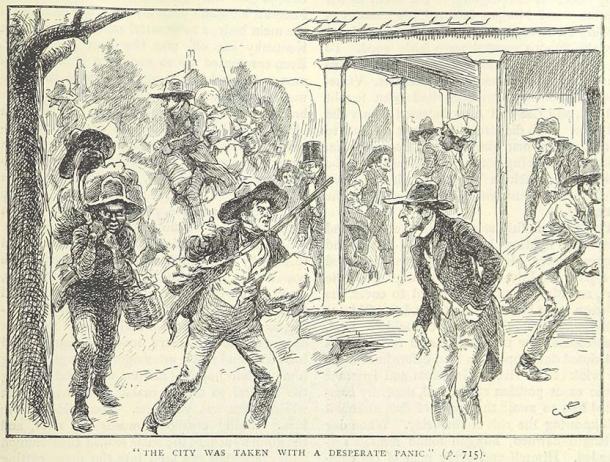
Civil War Surprise as Kentucky Farmer Unearths Valuable Coin Hoard
A Kentucky farmer was digging in his corn field earlier this year when he discovered over 700 coins. About 95% of the unexpected stash dated back to the American Civil War. This chance finding of a Civil War hoard included rare, minted coins and has now been branded “the Great Kentucky Hoard.”
According to the Numismatic Guaranty Company (NGC), who certified the coins' authenticity, the rare Civil War hoard of coins includes the “finest-known 1863 Double Eagles, as well as several interesting varieties and errors.” The lucky farmer from the Bluegrass State told Live Science that the discovery was “the most insane thing ever.”
Pulling Riches from the Earth: The Civil War Hoard
The finder of the hoard, which includes hundreds of gold coins dating to between 1840 and 1863, in addition to a handful of silver coins, decided to remain anonymous. “Those are all $1 gold coins, $20 gold coins, $10 gold coins,” stated the discoverer on GovMint.com as he pulled the coins from the Civil War hoard from his corn field.
- Rare Coin Hoard Worth $1m Discovered by Treasure Hunters Off the Coast of Florida
- Treasure Hunters Accuse FBI of Secretly Seizing Lost Civil War Gold
NGC stated that around 95% of the hoard is composed of gold dollars, and that it included “about 20 $10 Liberty coins and eight $20 Liberty coins.” A report in Live Science highlighted that “one of these coins can go for six figures at auction.” The Great Kentucky Hoard boasts 18 of them!
The rarest coin within the Civil War hoard is a 1863-P $20 1-ounce gold Liberty coin, which circulated from 1850 to 1907. What makes this coin particularly rare is that its face was not stamped with the words “In God We Trust.” These were added in 1866 after the end of the Civil War.

The Civil War hoard was made up of over 700 Civil War-era coins. (Numismatic Guaranty Co.)
Bury the Stash Quickly, Here Comes Morgan
Professor McNutt, a conflict archaeologist at the Georgia Southern University’s Archaeological Laboratory, told Live Science that the fact the coins were unearthed in Kentucky, which was neutral at the time, means that the hoard was most probably “buried in advance of Confederate John Hunt Morgan’s daring raid in June and July 1863.
Leading a force of 2,400 cavalrymen, Confederate General John Hunt Morgan’s raid from June to July 1863 left an indelible mark on the American Civil War. Over 46 days the raid covered more than 1,000 miles through Kentucky, Indiana and Ohio, destroying supply lines and causing panic among civilians.
Morgan’s guerrilla tactics confounded Union forces, allowing him to evade capture multiple times. While Morgan was ultimately arrested, his legendary raid cemented his reputation as one of the most daring and resourceful Confederate commanders of the American Civil War.

Panic in Louisville, Kentucky, as the troops of John Hunt Morgan near the city. One archaeologist has argued that the Civil War hoard was buried in advance of Morgan’s raid. (Public domain)
The Lost Legacy of Kentuckian Plunder
Because this coin hoard represents federal currency, McNutt suspects it may have been left by “Kentuckian's dealings with the federal government.” The archaeologist explained that many Americans affected by the Civil War became experienced with hiding goods and valuables from Confederate raiding parties.
Another example given of a Kentuckian stashing treasure was James Langstaff, who wrote a letter declaring he had buried “$20,000 in coins on his property in Paducah.” Furthermore, Live Science reported on a William Pettit, who buried “$80,000 worth of gold coins near Lexington.”
Because neither of these Civil war-era coin caches have been discovered to date, so much value is being associated with the recently discovered Civil War hoard, both financially and historically.
Are Federal Laws Damaging U.S. Archaeology?
American laws state that any historical finds made on private land “do not need to be reported.” Professor McNutt stressed that as a result the vast majority of ancient artifacts found on private land go straight to auction without ever being studied by archaeologists; a situation which he finds “frustrating.”
- The Controversial Origins of the Maine Penny, A Norse Coin found in a Native American Settlement
- Medieval Coin in Canada Challenges Story of North American Discovery
In this instance however, McNutt’s efforts investing time into developing close relationships with landowners through education and outreach have paid off. Thanks to the finder reporting the Civil War hoard discovered on his land, this particular “snapshot of the past” won’t be lost forever.
America's archaeology laws have faced harsh criticism for their perceived shortcomings, with critics arguing that fragmented legislation, insufficient funding and limited enforcement hinder the protection and preservation of archaeological sites and artifacts.
The U.S. Antiquities Act protects any “object of antiquity” even though it fails to define this term. The Archaeological Resources Protection Act (ARPA) addresses the ambiguity over this term claiming it means “any material remains of archaeological interest.” However, ARPA does not consider items under 100 years old, or paleontological items such as fossils, to be “archaeological.”
Top image: Representational image of gold coins in the ground. Source: QuietWord / Adobe Stock
By Ashley Cowie















